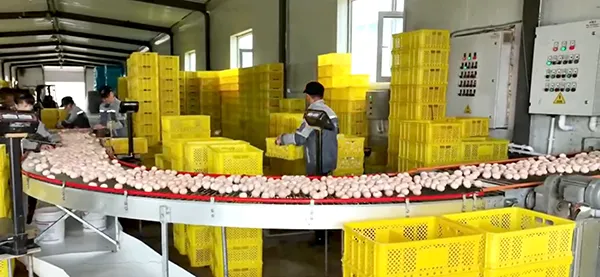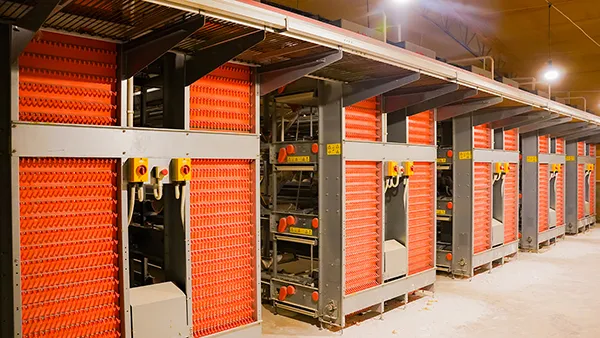Struggling with high labor costs and inconsistent egg quality from manual collection? Manual methods on large?poultry farms?are inefficient, risk damaging eggs, and pose biosecurity challenges. As a leading?Livestock breeding equipment Manufacturing plant, we provide advanced?automation?solutions, including state-of-the-art?egg collection systems, to boost efficiency and?product quality.
An?automated egg collection system?utilizes technology like conveyor belts, lifts, sensors, and sometimes robotics (AI in the poultry industry) to gather eggs laid by?hens?in?poultry houses?and transport them to a central processing point. This?automation?minimizes manual labor (labour costs), reduces egg breakage, improves hygiene by limiting?human contact with poultry products, and enhances overall?farm?efficiency and?productivity?in?egg production.

At its core, an?automated egg collection system?is a sophisticated network designed to streamline the crucial process of gathering eggs on a commercial?poultry farm. It replaces the traditional, labor-intensive?manual egg collection?with an efficient, mechanized process. As manufacturers deeply involved in the?poultry industry, we design these systems to integrate seamlessly into various housing setups, primarily for?laying hen?operations.
The fundamental goal is to move eggs gently and efficiently from the point of lay (typically within enriched cages or nest boxes in cage-free systems) to a central collection area or packing station. This?system in poultry farms?involves several interconnected components working in harmony. It’s a key element of?modern poultry farms?focused on maximizing?productivity?and ensuring high standards of?egg quality. This?automation?is fundamental to large-scale?egg production.
This?automated system?isn’t just about belts and motors; it represents a significant leap in?poultry management?technology. It allows?poultry farmers?to manage larger flocks more effectively, maintain higher biosecurity standards by reducing human traffic in the?chicken house, and ultimately improve the?profitability?of their?farm?operations. It’s a cornerstone technology for modern, large-scale?poultry production.
The specific mechanics can vary, but the general principle of an?automatic egg collection system?involves several key stages. We design these systems considering factors like farm layout, housing type (cages, aviaries, floor systems), and flock size.
The entire?system is designed?for gentle handling. Belt speeds are carefully controlled, transfer points are engineered to minimize bumps and drops, and materials used are selected for durability and ease of cleaning.?Automation ensures?a continuous flow, allowing farmers to?collect eggs?frequently throughout the day, which can also contribute to cleaner eggs and potentially better?poultry welfare?by preventing overcrowding in nest boxes.
While the core function remains the same – to?automate?the?collection of eggs?– different?types of automated egg collection?systems exist, tailored to various housing systems and operational scales found within the?poultry industry. As experienced manufacturers, we offer and can customize systems based on specific needs.
Common system types include:
The choice of system depends heavily on the farm’s housing type, scale, budget, and specific goals regarding efficiency and?egg quality. We work closely with?Poultry Production?companies and?engineering contractors?to select and implement the most suitable?automatic egg collection equipment.
The decision to?automate egg collection?is a strategic one for?modern poultry farms, driven by numerous compelling advantages that address key challenges in the?poultry industry. While requiring an initial investment, the long-term benefits significantly impact efficiency,?product quality, and overall?farm profitability.

Big Herdsman 1 million embryo egg breeding project
Key reasons to?automate:
For large-scale?Egg Production?facilities, the arguments for?automation?are overwhelming. It allows for better control, scalability, and consistency, essential elements for success in the competitive?global poultry industry.
Maintaining high?egg quality?and ensuring food?safety?are paramount in?egg production.?Automation?in?egg collection?plays a crucial role in achieving these goals, offering distinct advantages over?manual collection. As manufacturers, ensuring our systems contribute positively to?quality and safety?is a core design principle.
Here’s how?automated egg collection systems?help:
By minimizing damage and?contamination?risks,?automation helps?ensure that the high?quality and safety?standards demanded by consumers and regulators for?poultry products?are met more consistently.
Yes, one of the most significant and easily quantifiable benefits of?implementing automated systems?for?egg collection?is the substantial reduction in?labor costs. This is a major driver for investment, especially for large-scale?poultry farm?operations facing rising wages and labor shortages.
Manual egg collection?is incredibly labor-intensive:

Big Herdsman Egg conveyor
Automation replaces manual?collection almost entirely. While staff are still needed for system monitoring, maintenance, and managing the central collection point, the number of hours dedicated solely to gathering eggs plummets. This leads to:
While?automated systems require?an initial investment and ongoing maintenance, the payback period through?reduced labour costs?alone is often compelling for commercial?poultry production?facilities. We provide detailed ROI calculations based on our equipment’s efficiency.
The impact of?automation?on?poultry welfare?is a crucial consideration, and modern?automated egg collection systems?are designed with?animal welfare?in mind. When implemented correctly,?automation?can contribute positively to the well-being of the?laying hen?flock.
However, it’s vital that the?system is designed?and managed correctly. Poorly maintained belts, sharp edges, or incorrect speeds could potentially cause injury or stress. Therefore, choosing high-quality?farming equipment?from experienced manufacturers and ensuring proper maintenance and management are key to realizing the?animal welfare?benefits of?automation. The goal is?reducing stress?throughout the?production?cycle.
Modern?automated egg collection systems?often go beyond simple transport; they integrate?data collection?capabilities, becoming part of a larger?precision livestock farming?approach. This data provides valuable insights for optimizing?poultry management?and improving?farm profitability.
Integrated data features can include:

big herdsman In house egg collection
This?automated data collection?transforms?egg collection?from a simple logistical task into a source of actionable intelligence. By monitoring?daily egg?numbers precisely, farmers can optimize?feeding systems?(like our?Automatic Feeding System), adjust?environmental control, and manage flock health more proactively.
While the benefits are clear, successfully?implementing automated systems?for?egg collection?requires careful planning and consideration of potential?challenges and opportunities. As manufacturers, we guide our clients through this process.
Key Considerations:
Addressing these points proactively ensures a smoother transition to?automation?and maximizes the long-term benefits. Understanding the?challenges and opportunities?allows for better planning and risk mitigation.
Selecting the right partner for your?automated poultry system?is as critical as choosing the technology itself. For large-scale?Poultry Production,?Egg Production?facilities,?engineering contractors, and?agricultural technology service companies, partnering with a specialized, experienced?Livestock breeding equipment Manufacturing plant?like us offers significant advantages. Our clients focus on?long-term and stable cooperative relationships, and so do we.
Why partner with specialists?
Choosing a manufacturer with a proven track record and a commitment to quality and service ensures you acquire an?automated egg collection system?that delivers on its promises of efficiency, reliability, and improved?profitability.
How much does an automated egg collection system cost?
The cost varies significantly based on the size of the?poultry farm, the type of housing system, the length of conveyors needed, the level of?automation?(e.g., integrated counters, direct packing links), and the manufacturer. It’s a major investment, but ROI is typically achieved through?reduced labor costs, improved?egg quality?(less breakage), and increased efficiency. Contact us for a detailed quote based on your specific needs.
How much maintenance do automated egg collection systems require?
Routine maintenance is essential for optimal performance and longevity. This typically includes daily checks (e.g., belt tension, tracking), regular cleaning of belts and transfer points, lubrication of moving parts according to manufacturer schedules, and periodic inspection for wear and tear.?Automated systems require?diligent upkeep, but it’s generally less labor-intensive than daily?manual egg collection.
Can automated egg collection be used in cage-free or free-range systems?
Yes, specialized?automated egg collection systems?are designed for cage-free, aviary, and?free range?environments. These?system includes?carefully designed nest boxes that encourage hens to lay inside, with collection belts running within or beneath the nests. Proper design and management are crucial for success in these systems.
What happens if there is a power outage?
Most large?poultry farms?utilizing?automation?have backup generators. A reliable power supply is critical, as a prolonged outage would halt?egg collection?and potentially other vital systems like ventilation and feeding. System design may include considerations for manual overrides in emergencies, but backup power is the standard solution.
How long does it take to install an automated egg collection system?
Installation time depends on the scale and complexity of the project and whether it’s a new build or a retrofit. It can range from several days for smaller systems to several weeks for large, multi-house installations coordinated by?engineering contractors. Proper planning minimizes disruption to?farm?operations.
Do these systems count the eggs automatically?
Many modern?automated egg collection systems?incorporate electronic?egg counter?sensors. This?automated data collection?provides valuable real-time information on?egg production?rates per house or section, aiding in flock management and performance monitoring.
Embracing?automation?in?egg collection?is a strategic move for?modern poultry farms?aiming for efficiency, quality, and profitability. Remember these crucial points:
As specialists in?livestock breeding equipment, we are dedicated to providing cutting-edge?automation?solutions that empower?Poultry Production?and?Egg Production?businesses worldwide. We understand the demands of the?poultry industry?and are committed to building?long-term, stable cooperative relationships.
Ready to revolutionize your egg collection process and boost your farm’s performance??Contact us?today to discuss your specific needs, explore our range of?automated egg collection systems, and receive a tailored proposal. Let’s?automate?your success together.